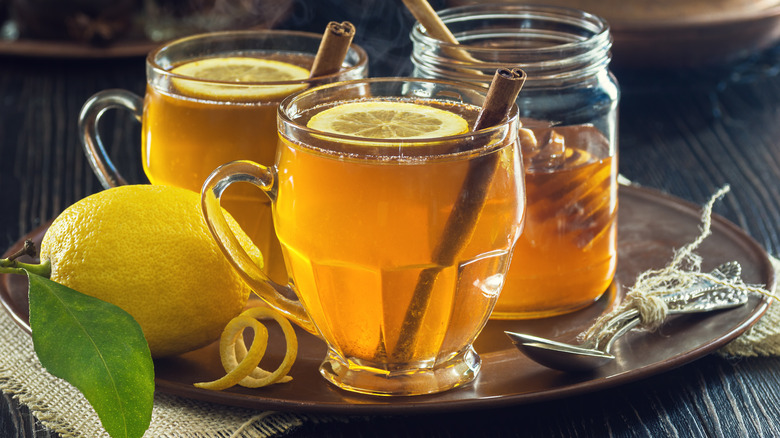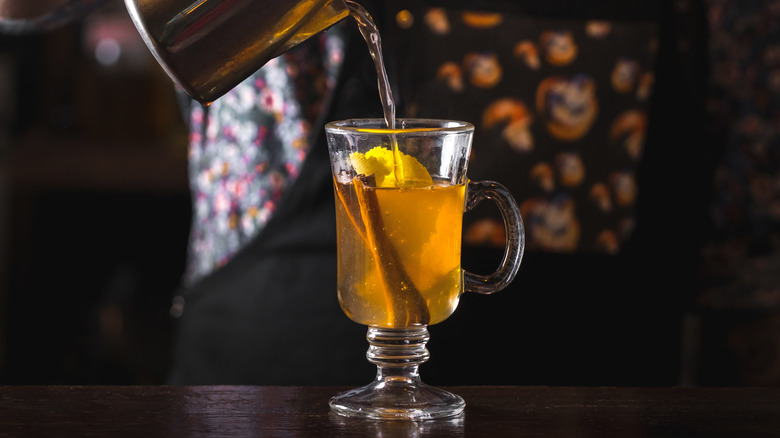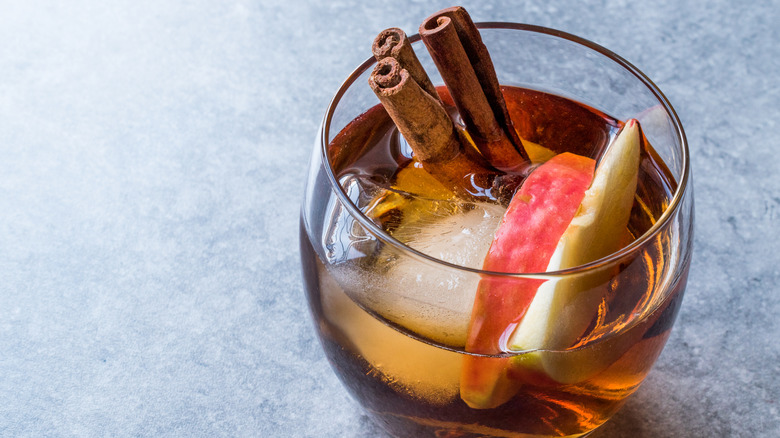The Disputed Origin Of The Hot Toddy
Something about the hot toddy conjures up images of cozy firelit parlors in Dickensian London or flu remedies concocted by grandmas in shawls.
Yet it's worth remembering that a hot toddy is, after all, a cocktail — even if we don't normally associate it with sleek mixologists or shimmering neon. And according to Epicurious, recipes vary and are pretty much countless.
That said, BBC Good Food lists the key ingredients as whiskey, honey, lemon, cinnamon, and cloves. It also suggests that it's an excellent drink for serving at winter shindigs. If so, this nixes the idea that toddies should mainly be enjoyed in bed while sneezing into a handkerchief.
Overall, the hot toddy is a drink that creates "hygge" vibes (as noted by Country Living, the Danish concept of embracing "feelings of cozy contentment"). And for sure, the welcome kick of whiskey, the sweetness of honey, the citrus zing of lemon, and the warming spices mix create a nicely layered drink to savor on chilly evenings.
And the whole "treatment for sniffles" element? As wine writer Victoria Moore explained in "How to Drink," vitamin C is for health, honey is to soothe, and alcohol is to numb (via Eater).
But where does this classic comfort drink actually come from — and how did it get to be so popular?
The hot toddy might have its roots in palm juice
The history of the toddy is actually up for debate. According to Vine Pair, you can trace its origins to India and a 17th-century drink called "taddy," made from fermented palm sap. The oldest record of the recipe is from 1786, where it was described as liquor mixed with hot water, spices, and sugar.
As outlined by British Food History, taddy was used by British officials in India to water down expensive imported beer from home. Over time, spirits, sugar, ginger, and lime made their way into the concoction. The recipe then seems to have traveled to Scotland and England, evolving along the way. For instance, as Eater points out, one recipe by the influential Victorian writer, Mrs. Beeton, included linseed, sun raisins, and licorice.
However, another version of the origin story suggests that the drink was an 1800s invention of an Irish doctor, Robert Bentley Todd. As described by Liquor Plus, he had quite a merry view of medicine, prescribing his patients a mixture of hot brandy, water, cinnamon, and sugar as a general cure-all.
Of course, both stories may be true — Dr. Todd might have heard about Indian taddy and created his version. Like many good things, the cozy ole hot toddy was possibly the joint effort of generations.
Toddies are always evolving
What Dr. Todd's brandy-laced recipe shows are that toddies weren't solely made with whiskey. In fact, formulas varied according to region. For instance, Jamaica Experiences shares a traditional dark rum version. And American recipes, such as Feast and West's, generally call for bourbon rather than Scotch. You can also experiment with different spices or throw in ginger ale or apple cider.
As Vine Pairs points out, fashionable versions ramp up the fruitiness with cranberry or grapefruit juice mixers. The Spruce Eats also makes the case for adding tea, replacing whiskey with gin, or trying out sweet orange liqueur.
Some establishments even have their own hot toddy cocktails; for instance, Paley in Los Angeles served a mezcal toddy known as The Oaxacan. It turns out that this old-time drink is pretty versatile, meaning you can shape it to different occasions and tastes.
Plus, cold toddies are very much a thing too. As outlined by Bon Appétit, to mix one up, you'll need rye whiskey, Earl Grey tea, oranges, lemons, cinnamon sticks, ginger, cloves, honey, and ice. And sure, serving a toddy frigid might strip it of its homey feels, but it does mean you can slug it down on a balmy summer day. Because why should you only get to enjoy this classic drink in the chilly seasons?


